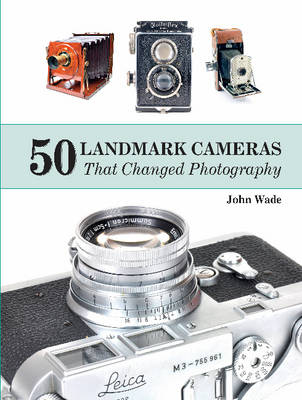11%OFF

Stock image for illustration purposes only - book cover, edition or condition may vary.
50 Landmark Cameras That Changed Photography
John Wade
€ 52.27
€ 46.65
FREE Delivery in Ireland
Description for 50 Landmark Cameras That Changed Photography
Hardcover. Num Pages: 256 pages, illustrations. BIC Classification: AJG; WCX. Category: (G) General (US: Trade). Dimension: 242 x 314 x 28. Weight in Grams: 1860.
The Daguerreotype Camera of 1839 is a photographic landmark. It introduced the first practical method for taking a photograph, although what is generally acknowledged as the first photograph was actually taken thirteen years before with a different type of camera by NicA (c)phore NiA (c)pce. The Leica was the first camera to make the 35mm format popular, but it was by no means the first camera to use 35mm film. Likewise, Polaroid wasn't the first to produce an instant picture camera, but was, surprisingly, the first company to introduce an autofocus single lens reflex. The history of the camera is flush with similar anomalies. This lavishly illustrated book with over 460 pictures looks at the cameras that became landmarks and analyzes how and why they influenced future design a sometimes in a big, important manner, other times in a lesser but still significant way.
Product Details
Publisher
Schiffer Publishing Ltd
Format
Hardback
Publication date
2016
Condition
New
Weight
1860g
Number of Pages
256
Place of Publication
Atglen, United States
ISBN
9780764350047
SKU
V9780764350047
Shipping Time
Usually ships in 15 to 20 working days
Ref
99-50
About John Wade
John E. Wade II is an investor, philanthropist, television producer, and former CPA. Though retired, he is busier than ever attending to his calling to engage the world and spread a message of hope for a true heaven on earth. He is the founder of Soldiers of Love, a nonprofit dedicated to making a long-term impact on all ten elements of his tenets. He lives in New Orleans.
Reviews for 50 Landmark Cameras That Changed Photography
The chronological approach taken is both sensible and enjoyable, as it does give a flavour of how camera production and development occurred, incorporating changes in technology as it went. The text is both informed and informative, managing to give enough factual information that balances with Johns obvious enthusiasm and love for his subject(s). I love seeing cameras displayed with their occasionally mad accessories - cameras that I would not give houseroom to suddenly take on an allure (to me) when fully kitted out - you wonder what the design team from the American firm Univex were 'on' when they came up with some of the add ons for their already bonkers half frame camera the Mercury - the shot of this camera with i's Flash Gordon inspired lever wind, rangefinder and flash bulb unit is truly unforgettable. As with both of John's previous Schiffer titles (still available from the publisher) this is a wonderfully printed and illustrated book, and for me contains the essence of why I collect cameras and photographica - there's facts, anecdotes, a few mysteries and a decent serving of barminess... from the camera designers I mean, not from the author! - Timothy Campbell, 'Photographica World'
